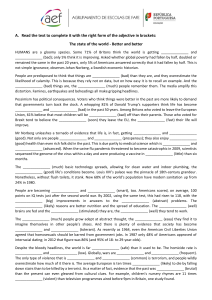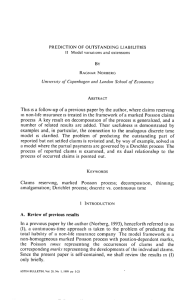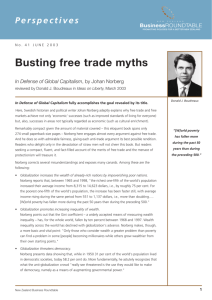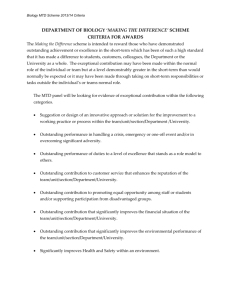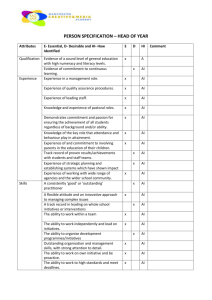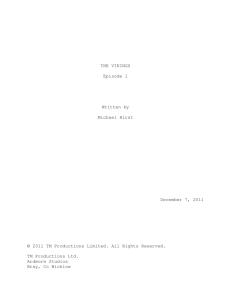Prediction of Outstanding Liabilities in Non
advertisement
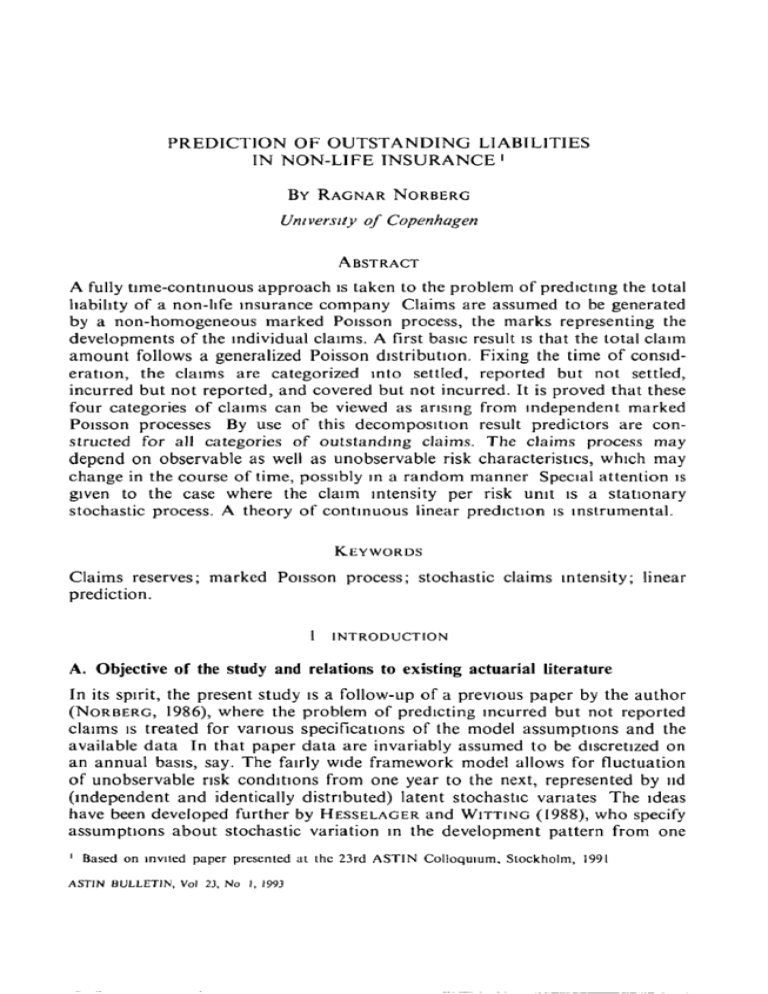
P R E D I C T I O N O F O U T S T A N D I N G LIABILITIES
IN N O N - L I F E I N S U R A N C E I
BY
RAGNAR
NORBERG
Umverstty of Copenhagen
ABSTRACT
A fully time-continuous approach is taken to the problem of predicting the total
liability of a non-hfe insurance company Claims are assumed to be generated
by a non-homogeneous marked Polsson process, the marks representing the
developments of the individual claims. A first basic result is that the total claim
amount follows a generalized Poisson distribution. Fixing the time of consideration, the claims are categorized into settled, reported but not settled,
incurred but not reported, and covered but not incurred. It is proved that these
four categories of claims can be viewed as arising from independent marked
Polsson processes By use of this decomposition result predictors are constructed for all categories of outstanding claims. The claims process may
depend on observable as well as unobservable risk characteristics, which may
change in the course of time, possibly in a random manner Special attention ~s
gwen to the case where the claim Intensity per risk unit IS a stationary
stochastic process. A theory of continuous linear pre&ctlon ~s mstrumental.
KEYWORDS
Claims reserves; marked Polsson process; stochastic claims intensity; linear
prediction.
1
INTRODUCTION
A. Objective of the study and relations to existing actuarial literature
In its spirit, the present study is a follow-up of a previous paper by the author
(NORBERG, 1986), where the problem of pre&cting incurred but not reported
claims is treated for various specifications of the model assumptions and the
available data In that paper data are invariably assumed to be dtscretlzed on
an annual basis, say. The fairly wide framework model allows for fluctuation
of unobservable ask con&tlons from one year to the next, represented by nd
(independent and identically distributed) latent stochastic varlates The ideas
have been developed further by HESSELAGER and WITTING (1988), who specify
assumptions about stochastic variation in the development pattern from one
I Based on invited paper presented at the 23rd ASTIN Colloquium, Stockholm, 1991
ASTIN BULLETIN, Vol 23, No I, 1993
96
RAGNAR NORBERG
year to another. This issue has been pursued also in a recent paper by
NEUHAUS (1992). The present paper carries on in two directions of increasing
generahty.
In the first place it undertakes to construct a continuous tame stochastic
process description of the occurrence and development of insurance claims, the
purpose being to gain economy of notataon as compared wath the dascrete time
set-up, a n d - - m o r e I m p o r t a n t - - t o look for possibihties of refining the model
apparatus and the statast~cal methods. A first draft of the xdeas was presented
In an earher paper by the author (NORBERG, 1989). Notable prevaous works on
pre&ctaon of outstanding claams in a time-continuous setting are contributed
by KARLSSON (1976), who discusses the effect of correlation between the claim
a m o u n t and the delay time from occurrence to notification m a renewal
process, by ARJAS (1989), who clarifies adeas in a general stochastic process
framework, and by JEWELL (1989), who treats the special problem of pre&ctmg
the number of incurred but not reported claims in the case of a homogeneous
Poisson process with r a n d o m claim intensity, constant m time.
In the second place, fluctuations and trends in risk conditions are accommodated in a more flexible manner than in prevaous works Fluctuating unobservable risk conditions are represented by a latent stochastic process, which may
be taken to have a certain inertness, and observable risk characteristics are
accounted for by covariates (explanatory, exogeneously gwen quantities) that
m a y change over tame. Thus, one is not compelled to lump all varying risk
factors into the unknown and to postulate that risk factors an different years
are independent selectaons from some c o m m o n &stnbution.
B. Outline of the paper
Prediction of habfllties is a major issue in any assessment of the financial
strength of an insurer, whether performed in public supervision or in c o m p a n y
management. The present study adopts the point of view of a regulatory
authority conducting solvency control based on the break-up criterion,
whereby the relevant liabilities are the total outstanding payments m respect of
claims that the insurer is under contract to cover at the time of consideration
Section 2 explicates the objective of the solvency control and describes the
structure o f the observable data. Section 3 presents the basac model, a so-called
marked Poisson process: claims occur in accordance with a non-homogeneous
Poisson process, and to each in&vidual claim is associated a random " m a r k "
representing its development from occurrence to final settlement. A key result
as that the claims process may be viewed as the outcome of a Poasson number
of claims with independent and identically &strlbuted occurrence epochs and
marks. Consequently, the total claim amount follows a generalized Poasson
distribution Section 4 provides further useful results on &stributlonal properties of the process. Fixing the time of consideration, the claims are categorized
into settled, reported but not settled, incurred but not reported, and covered
but not incurred. It ~s proved that these four categories of claims arise from
PREDICTION OF OUTSTANDING LIABILITIES IN NON-LIFE INSURANCE
97
independent marked Poisson processes. From this basic decomposition result
the distribution of the total outstanding liabihty is easdy found, and adequate
reserves can be computed. This is the topic of Sectson 5. In Section 6 the model
~s extended by letting the claim intensity be a stochastic process representing
fluctuating unobservable risk conditions A linear predictor of the outstanding
liability m respect of not reported claims Js obtainable by methods taken from
a recent paper by the author (NORBERG, 1992) - - it is an integral with respect
to the process counting the reported claims. Section 7 offers a sketch of how
observable risk factors can be represented by covarmtes that may change in the
course of time. Section 8 provides some numerical dlustrations.
2. THE SOLVENCY CONTROL SYSTEM AND THE DATA
A. The break-up point of view in solvency control
Consider an insurer who has been running business m one or more hnes of
insurance since ume 0, say, and who ~s subjected to solvency control at some
subsequent ume 3, henceforth referred to as the present moment. The solvency
assessment is based on the break-up scenario, by which underwriting of new
business is assumed to cease at t,me r. Thus, only outstandings for which
habfllty has been assumed prior to time z are relevant, and, since the premiums
for this part of the business have already been collected, the reserve provided at
time r must be adequate to meet these claims. Possible excess of premiums over
claims in the future cannot be counted as available for covering currently
assumed liabilities (no counting of chickens before they are hatched). In this
perspectwe ~t ~s henceforth understood that all quantities introduced are related
to coverages secured by contracts m force prior to or at time r. They could
properly be equipped wath an index 3, but this ~s omitted to save notation.
B. Data from policy records
For the time being focus is on one single hne of business, a mass branch like
non-Industrial fire or automobile insurance. The portfolio is made up of many
small risk umts so that a single claim has no significant impact on the size and
the composition o f the portfolio and, therefore, need not be related to the
individual risk from which it stems Thus, the macro viewpoint of the collective
theory of risk is adopted, and It IS assumed that the information provided by
the policy records at time t is adequately summarized by:
w(t), the risk exposure per time unit at time t
The exposure rate w(t) may be a thought of as a simple measure of volume or
size of the business, but later on it wdl be allowed to depend on covarlates
describing the composition of the portfolio. In the break-up context the
function w will typically look as in Figure 1. Future exposure after time r
pertains to contracts that are currently m force In practice they wdl expire m
finite time so that w (t) = 0 for t large enough, but it will suffice here to assume
98
RAGNAR NORBERG
that the total exposure,
oo
(2.1)
W =
i
w ( t ) dt,
0
is finite.
= t
'7"
FIGURE [ E x p o s u r e of business written up to time z
C. Data from claims records
The claims statistics is a file of records, one for each individual claim. Associate
with a claim the following quanmies, which can be read from the completed
claims record after the claim has been settled:
T, the time o f occurrence,
U, the waiting time from occurrence until notification to the insurer,
V, the waiting time from notification until final settlement,
Y(v'), the mdemnity paid m respect of the claim during the time interval
I T + U, T + U + v'], i.e. within v' time umts after its notification,
Y = Y(V), the final claim amount
Y
Y(v')
0
T
T+U
T+U+v'
T+U+V
FIGURE 2 Occurrence and d e v e l o p m e n t o f a c l a i m
PREDICTION OF OUTSTANDING
L I A B I L I T I E S 1N N O N - L I F E I N S U R A N C E
99
A typical claims history, as described by these quantities, is depicted in
Figure 2.
It is convenient to assemble the quantities describing the development of the
claim after its occurrence in
z = ( u , v, r , {Y(v'), 0 < v' < v}),
and to represent the claim as the pair (T, Z). The space of all possible
realizations of a claim is (0, oo)x 2/, where ,7/ is the space of all possible
developments.
The claims for which liability has been assumed by time z is a collection of
points (T,, Z,) in the claims space. Let the claims (if any) be numbered in
accordance with the chronology of their occurrence, 0 < Tz < Tz < ... (implymg that no two claims occur simultaneously). Introduce
N ( t ) = ~,
l{T,<t} ,
the number of claims occurred by time t,
and abbreviate
N = hmt~
N ( t ) , the total number of claims
The occurrence epochs T, determine the counts {N(t)}t~ 0, and vice versa;
(2.2)
T, = lnf{t; N ( t ) > t}.
The claims data that will eventually be observable is
(2.3)
{(T,, Z,)}i ~,~N.
3. T H E B A S I C M O D E L
A. Review of some properties of Poisson distributions
Proofs of the standard results to be listed here can be looked up in e.g. BEARD
et al (1984).
A non-negative integer-valued random variable N is Poisson d~stributed with
parameter W(>_ 0), written N ~ P o ( W ) , if
(3.1)
P{N=n}
Wn
= - -e-W,
n!
n = O , 1, ..
Let Y,, i = 1, 2 . . . . be nd selections from a distribution P r , all independent
o f N , ~ P o ( W ) Then the random variable
N
(3 2)
X = L
Y,
tml
(interpreted as 0 if N = 0) is said to have a generahzed Potsson dtstribution
with frequency parameter W and j u m p size distribution P r , abbreviated
)¢'~ Po(W, Pv). T h i s distribution is given by
(3.3)
Px
e- w
=
n-O
~!
B Yn. ,
100
RAGNAR NORBERG
where the topscrlpt n* s]gmfies n-th convolution. Its first three central moments
are
(3.4)
m~ ) = W I yk er(dy),
k = 1, 2, 3,
provided that the first three moments of Pr exist.
If X (j), j = 1. . . . , k, are independent and X (j),-~ Po(W (j), Pr,,) for each j,
then
k
(3.5)
X = E
X(j) ~ Po(W, Pr),
J=l
with
k
(3.6)
W = E
W(J)'
j=l
(3.7)
PY - ~ : l
W(J)PY'"
w<,,
Putting all jump sizes equal to 1, (3.4)-(3.7) speciahze to results for Poisson
&stributions.
There are at least two reasons why the generahzed Poisson &stribut~on plays
an important role in risk theory. First, it is widely held to be a reasonable
description of claims generated by a large and fairly homogeneous portfoho of
risks and, second, it ~s computationally feasible. In particular, the moments are
given by simple exphcit formulas, confer (3.4), and there exist a number of
techmques for computing tad probabilities and fractdes m such &stnbutmns,
see e g. BEARD et al. (1984).
B. Basic model assumptions for the claims process
The starting point is the process of occurrences of claims. It is assumed that
claims occur in accordance w~th a non-homogeneous Po~sson process with
intensity w(t) at hme t > O. In short,
(3 8)
(T,}~,~N-- Po(w(t); ~ >_O)
This means precisely that the process {N(/)}t~ 0 has independent increments
and N ( t ) - N ( s ) , , ~ eo(S~s w(t')dt') for each interval (s, t]. In particular, since
the total exposure m (2 1) is finite, the total number of claims ~s finite with
probability 1 and Is a Pomson variate; N ~ Po(W). The claims epochs are
constructed from the counting process by (2.2) Let {Z(t)},~ 0 be a family of
random elements m .2" which are mutually independent and independent of
{N(t)},~o, and denote the distribution of Z(t) by Pz:t. The m&vldual claim
developments are constructed as Z, = Z(T), t = 1 , . . , N Phrased less precisely, the clatm developments Z, are assumed to be mutually mdependent,
PREDICTION OF OUTSTANDING LIABILITIES IN NON-LIFE I N S U R A N C E
and the conditional distribution of Z,, given
Adopting standard terminology, the random
associated with the occurrence epoch T,, and
Potsson process with intensity {w(t)}t2 o and
{Pzl,},~0. In short,
(3.9)
10]
{N(t)}ta0, depends only on T,.
element Z, is called the mark
the process is called the marked
position-dependent marking by
{(T,, Z,)}is,~N "~ P o ( w ( t ) , ezl,; t >_ 0).
C. An alternative construction of the process
Let the statement T s dt signify that T takes its value in a nelghbourhood of
extension dt around t. The meaning is clear if T is real- or vector-valued, and
the device can be adopted also In more general spaces. The joint probability
distribution of the observables is given by
(3.10)
P { N = n, (T,, Z , ) e (at,, dz,), i = 1, . . . , n}
e
w(t,)dt,,
w t t o u t I .. e
e-I,~'(°a' I~I pzlt,(dz,)
t=l
(3.11)
= e
-If
w(t,)dt, Pzl,,(dz,)
t=l
wn
(3.12)
=
e - W n!
n!
PT.z(dt,, dz,),
~=]
where W is the total exposure defined by (2.1) and
(3.13)
w(t)dt
Pr.z(dt, dz) - - W
Pzl,(dz).
It is seen that PT, Z is the joint distribution of a random pair (T, Z), where T
has a marginal distribution P r with density w ( t ) / W , t > 0, and Z has
conditional distribution PzIt for fixed T = t. The expression (3.12) serves to
prove the following result.
Theorem 1 : The marked Poisson process in (3 9) can be viewed as the outcome
of a two-stage procedure: first generate N ~ P o ( W ) , then select a random
sample of N pmrs from the distribution PT.Z given by (3.13), and order them
by the size of the first entry to obtain {(~, Z,)}i~,~N.
D. The distribution of the total liability
Let X denote the total liability assumed by the insurer up to time r. It is of the
form (3.2), with N and the Y, distributed as specified in Paragraph B above.
Being a symmetric function of the Y,, the sum on the right of (3.2) does not
102
RAGNAR NORBERG
depend on the chronological order of the claims. Thus, by virtue of Theorem 1,
the Y, can be replaced by nd selections from the marginal distribution PY
obtained from the joint distribution m (3 13) upon integrating out the other
varlates •
I
(3.14)
Pv(dy) =
w(t) Pyit(dy) dt
t>0
W
(The notational device employed in PY and PYd~ is selfexplainmg and will be
used throughout: the marginal distribution of a variate is denoted by the
symbol of the joint distribution equipped with the appropriate subscript.) This
together with (3 3) and (3.4) proves the following result:
Corollary to Theorem 1: The total claim amount Is a generalized Polsson
variate, X ~ P o ( W , Py), with I4" and Py given by (2.1) and (3.14). Its
distribution is given by (3.3), and the three first moments are
(3.15)
w(t) I
m(~)= I
t>0
yk pyIt(dy) dt,
k= 1,2,3.
y>0
Remark: A heuristic motwation of the result IS obtained from (3.5)-(3.7) upon
writing X = . ~ X(dt), the " s u m " of claim amounts in small mtervals dr, t >_O.
Each X(dt) is a sum of indlvldual claim amounts, the number of clmms N(dt)
being Po(w(t)dt) and the individual claim amounts being lid selections from
Prlt" []
4. FOUR CATEGORIES OF CLAIMS
A. Paid and outstanding claims
As seen at time T, the claims may be categorized as settled (s), reportednot-settled (ms), incurred-not-reported (inr), or covered-not-recurred (cm). For
each t >_ 0 and g = s, rns, mr, cni, let 2 , g denote the set of all possible
developments that make a claim occurred at t~me t belong to category g. These
sets are defined precisely as
(4.1)
.g',,~ = {z, t + u + v <_ r},
(4.2)
(4.3)
.X/,,"' = {z; t+u <_~ < t+ u+v},
y,,,r = {Z; t < r < t+u},
(4.4)
.2",if' = {z, t > r}.
By definition, 2",,° = 0 for t > r and 9 = s , rns, mr, .;¢,c,,=.g/ for t > r , and
.4.,c"' = ¢) for t < Z. For each t the sets / o form a partition of the space .%,
that is,
(4.5)
Ug./, ° = Z , / o
i--1,4,o" = O, o 4' 0'.
P R E D I C T I O N O F O U T S T A N D I N G L I A B I L I T I E S IN N O N - L I F E I N S U R A N C E
103
The acronyms inr and rns are shorthand for the commonly used ibnr and
rbns, the redundant " b u t " being dropped m incurred but not reported and
reported but not settled. The term cni (NORBERG, 1989) represents claims
related to what is usually called the unearned premium reserve.
In accordance with the categorization (4.1)-(4.4) the process in (2.3) decomposes into the component processes
(4.6)
{(T°, Zfl)}l~,~N,, 9 = S, rns, inr, c m .
The construction is obvious: for each 9 the process counting the 9-claims is
defined by Ng(t) = ~, IiLg~ ' z,~,'~), the epoch of occurrence of the i-th 9-claim
is T,g = mf{t; N g ( t ) >_ i}, and its development is Z,° = Z(T, g)
The total liabihty in (3.2) decomposes accordingly into
(4.7)
X = X" + X~"~ + X'"r + X cm ,
where the components on the right are the total habfllties m respect of claims in
the different categories,
(4.8)
Xg = Z IIz,~.2"~l Y' =
l
Z
Y'g'
I~l~N °
Q = s, rns, mr, cm
By time ~ the s-part is paid, the rns-part splits unto a pard part,
xprns
~
y r,,s(~_ T,..... U 7 9 ,
Z
I ~t~N ~
and an outstanding part,
(4.9)
x°'°s =
Z
(YTs-v,r"'(
T y - U;"O),
I < t < N "J
and the inr- a n d c m - p a r t s are outstanding. The last-mentioned two components
can conveniently be lumped Into
(4.10)
X"" = X'"" + X c"' =
~,
YF,
I <l<N"
the hability in respect of not reported (nr) claims defined in accordance with
(4.1)-(4.4) by
(4.11)
.2"t"r = . ? ' / " ' U . 2 " / " ' = {z; t + u > r } .
The process of nr-clalms is well defined by (4.6) for g = nr
The total outstanding liability at time r is
(4.12)
X ° = X .... + X,r,
and a major issue m the solvency assessment is the prediction of this
quantity.
104
RAGNAR NORBERG
B. The joint probability distribution of the component claims processes
The following result is basra in the sequel.
Theorem 2: The component processes in (4.6) are independent, and for each
g = s, rns, l n r , cni,
{(Tf, Zf)}i~,~N, ,-~ Po(wO(t), P~,; t > 0),
with
(4.13)
(4 14)
w ° ( t ) = w ( t ) Pz.,{.z?},
P~.,,(d~) = ez~,(dz)
--,Z~...~,t
_
g
_
Pz.,{J,, q}
Proof: The component processes in (4 6) are determined by the aggregate
process in (3.9) and vice versa, and so the event appearing in (3 10) can be
equivalently stated in terms of the component processes From (4.5) it follows
that ~a Pzr,{Y',g} = 1 for each t. Thus, the likelihood in (3.12) is easily rewritten
as
(4. ~5)
P{('Io{N g = n a, (Tfl, Z, °) e (dt,°, dz,g), i = 1 , . ,
nO}}
no
=
- -
e
- -
Hg!
not
g (dt, , dz,)
PT, Z
,
i =1
where
oo
(4.16)
W° =
i
wa(t) dr,
o
with wg(t) defined by (4.13), and
(4.17)
P~,z(dt,
dz) - P r 'z ( d t , dz) - w Y ( t ) d t P~,,(dz), z E / , °
g
Wg
Wg
The result now follows by the product form of (4.15) and comparison with
(3 10)-(3 13) and Theorem 1 []
The result says that g-claims occur with an intensity which Js the claim
intensity times the probability that the claim belongs to the category g, and the
development of the claim is governed by the conditional distribution of the
mark, given that it is in category g. Accordingly, the quantity W g in (4.16) may
be termed the total exposure m respect of claims of category g or just the
g-exposure. The &stribution P~,z Is just the conditional distribution of (T, Z),
given that Lt is a g-claLm.
PREDICTION OF OUTSTANDING LIABILITIES IN NON-LIFE INSURANCE
105
5. PREDICTION IN THE BASIC MODEL
A. The prediction problem
A reserve must be provided at time z to meet the outstanding liablhty. Let . ~
denote the statistical reformation available by time r. It consists of the histories
up to lame r of all mdiwdual clmms that have been reported (r) by that time,
that ~s, occurred at some lame t_< z and with development m
The problem of providing an adequate reserve amounts to predicting X ° in
(4.12) on the basis of its condltmnal &stributmn, given ~ .
B. Predicting the orns-liability
As for the term X ..... on the right of (4.12), the rns-claims are conditionally
independent, given . ~ . Thus, the predictive distribution of X .... 1s the
convolution o f the conditional distributions o f the individual terms in (4.9).
Now, the conditional distribution of the size of an individual claim Yt rn~ may
depend in a complex manner on its development up to time z. Matters may
be simplified greatly by discarding the detailed information {Y["'(v');
O _ < v ' < r - Y , rlls - U , r~s }, and conditioning only on T,rns = t , , U,rtls = u , , and
Erns>
y f n s s ( r - T , rns - U[.~) = y,. This operation involves only the bivanate
distribution of (U, Y) for fixed T = t,, and the relevant pre&ctive &stributlon
of Y["~ is given by
(5.2)
Pu, vlt,(du,, dy)
ev;~,lt,,~,.y,(dy) =
I
Pu,
YIt I
, y > y,.
(du,, dy')
Y' > )'r
Thus, the non-central predichve moments of Y,. . . . y rns ( z - T,. . . . U,rn~) are
( y _ y , ) k prr.,it,.,,,y,(dy),
a}k) =
0
and the first three central moments are
(5.3)
m} I) = a} 1),
(5.4)
m~2) = a}2 ) - (a~')) 2 ,
(5.5)
m}3) = a}3)- 3 a}2) a} ') + 2 (a}')) 3 .
Since the terms m (4.9) are independent, the three first predictive moments of
X °ms are
(5.6)
m~)°"'l ~ =
E
rn}~)'
k = I, 2, 3.
106
RAGNAR NORBERG
C. Predicting the nr-liability
The term X "r on the right of (4.12) is independent o f . G , and is to be assessed
on the basis of its marginal distribution. By Theorem 2, all results in
Paragraphs 3C-D carry over to the process of nr-claims - - j u s t insert topscript
nr in all symbols. In particular, formula (3.15) apphes and, recalling
(5.7)
w"r (t) = w (t) (1 - Pvl, ( r - t)),
I
Py¢,(dy)
.r
=
(5 8)
Pv. r,,(du, dy)
U>T--t
1 -
P uI,
(r - t)
one obtains
(5.9.)
m~!, = f
J,>o
= I
Wnr(t) f
yk P~,(dy)dt
dy>O
w(t) I
t>0
I
u>r-t
YkPu, vt(du, dy) dt,
k= 1,2,3.
y>0
D. Predicting the total outstanding liability
By Theorem 2, the liability components X .... and X "r are conditionally
independent, given ~ . Thus the first three predictive moments of the
outstanding claims X ° m (4.12) are just the sums of the corresponding
moments in (5.6) and (5.9);
(5.10)
rn~!~=m(kx!,,,~;+m~),,,
k= 1,2,3.
An appropriate reserve is the first moment given by (5.10) with k = I. A
fluctuation loading may be provided by adding a multiple of the standard
deviation As an alternative to this ad hoc method, one may take the upper
e-fracUle (e.g. e = 0.01) of the predictive distribution, or some approximation
of it based on the first three moments in (5.10).
6. UNOBSERVABLE RISK C H A R A C T E R I S T I C S MO D ELLED BY
R A N D O M L Y F L U C T U A T I N G CLAIM INTENSITY
A. Model assumptions
In addition to observable risk characteristics there may be risk conditions that
are not observable or whose effects are difficult to model exphctly by
covarlates. If they are judged to be of importance, they can be modelled by a
stochastic process representing the unknown
PREDICTION OF OUTSTANDING LIABILITIES IN NON-LIFE INSURANCE
107
Only random fluctuations m the claim intensity will be discussed here. It is
assumed that the intensity is of the multlplicative form
w(t) 19(t),
(6.1)
with {w (t)},z0 a non-negative and nonrandom function representing an observable measure of risk exposure per time unit, and O ( t ) is a non-negative
" p r o p o r t i o n a l h a z a r d " factor representing unobservable risk conditmns that
may vary over time. Assume that O = {O(t)}r~0 is a stationary stochastic
process with mean and covariance function denoted by
(6 2)
E 19 (t) = fl,
Cov (O(s), O(t)) = p ( l t - s l ) ,
(6.3)
The set-up of Section 3, with w ( t ) replaced by (6.1), is taken as the
conditional model, gwen 19.
B. Prediction of the orns-liability
The predictive distribution of X °rns remains the same as in the previous section
since the marks {Z(t)}t>_o are independent of {N(t), 19 (t)},z 0 . In particular, the
first three predictive moments are gwen by (5.6).
C. Linear prediction of the nr-liability
Prediction of X nr now becomes more mtrmate since ~ contains partial
information on O, hence also on the nr-clatms. A feasible approach is provided
by the theory of linear predictmn in t~me-continuous processes presented
recently by the author, see NORBERG (1992) for a full account with proofs. The
procedure goes as follows.
The liabxhty X nr is to be predicted from the observed claims process,
{Nr(t)}o<c~,, which Js a sufficJent statJstm. Consider inhomogeneous linear
predmtors of the form
(6.4)
)~,~r = go + f
J
g(s) Nr(ds) = g0 + E
I{T,+U,~r} g(Tj)-
O<s<r
The performance of a predictor )[,,r ~s measured by the mean squared error,
= E()?'r-x"r) 2, which IS the squared norm of ) ( " r - X "r with
respect to the usual tuner product m the space o f squared integrable random
variables, .~X, Y>> = E ( X Y ) and IIX[{z = <~X, X>> The optimal linear predictor is the projectmn of X "r onto the hnear space of functions of the form (6.4).
Denote it by
II)?"r-x"rll2
(6.5)
£nr = )'0 + f
y(S) Nr (ds).
d 0<s~r
108
RAGNAR NORBERG
The constant term ?o and the function {Y(/)}0<t~, are determined by the
following normal equations, which are analogous to those for the discrete case
(think of the integral in (6.4) as a sum of terms Nr(ds) multtphed by
coefficnents 9 (s)) :
EXnr = ?o + ~
(6.6)
~(s) EN~(ds),
d 0<sz~r
(6.7)
Coy
( x "~, N'(dt)) = ~
~(s) Coy (Nr(ds), Nr(dt)),
d 0<s~r
0 < t < r The moments appearing m these equatxons are easily obtained by
heuristic reasoning. First, introducing
m~(t)=w(t)
(68)
I
I
u>~-t
(6.9)
yPtr, vl,(du, dy),
y>0
wr(t) = w(t) Puu,(r-t), 0 < t _ < r ,
form the conditional moments
E(X"rlO) =
m'r(s) O(s) ds,
0
E(N~(dt)lO) = w'(t) O(t) at,
Coy (X n~, N~ (dt)lO) = O,
Coy (N~ (ds), Nr (dt)lO) = ~Ss,t Mr(1) O(l) all,
where dr,, is the Kronecker delta, 1 for s = t and 0 otherwise.
The first relatxon is obtained upon replacing w(t) in (5.9) by the product in (6.1). The remaining relatvons follow easily from the fact
that {N'(t)}o<,~lO'-. PO(Wr(t) O(t); 0 < t < z ) and the conditional independence of X"' and {N'(t)}0<,~T. Now, form the uncondmonal moments
by use of the general rules E X = EE(XIO) and Cov (X, Y) = C o v (E(XIO),
E(Y[O))+ E Cov (X, Y]O):
OD
E X .~ =
S
m'r(s) ds fl,
0
ENr(dt) = wr(t) dtfl,
oo
Coy (X "~, N ~(dt)) =
S
m"r(s) p (It - sl) ds w~(t) dt,
0
Coy (Nr (ds), Nr (dt)) = wr (s) p([t-s[) wr (t) ds dt + 6s,, mr(t) flat
PREDICTION OF OUTSTANDING LIABILITIES IN NON-LIFE INSURANCE
109
Upon substituting these expressions, (6.6) becomes
i
(6.10)
l
m"r(s) d s f l = y o +
o
y(s) w r ( s ) d s f l ,
o
and, after dwlding by wr(t) dt on both sides, (6.7) becomes
m"r(s)p(It-s[)ds =
(6.11)
wr(s)p(It-sl)ds+7(t)fl, O < t < r
o
Thus one is left with the problem of first solving y(.) from (6.11), which is an
integral equation of the Fredholm type. Then one solves the constant term Y0
from (6.10) In general, a numerical procedure must be arranged for each
specification of Pzl, and p
D. The case with exponential covariance function
A reasonable specification of the covarlance function m (6 3) is
p ( [ t - s l ) = 2e -~`l'-st .
(6.12)
Inserting (6 12) m (6.11) and dividing on both sides by 2 yields
mt'r (s) e ~('-') ds +
(6.13)
0
m"r (s) e ~('-') dr
t
=
y(s) wr(s)e':('-')ds +
y(s) w r ( s ) e ~ ( ' - ' ) d s + y ( t ) fl
Assume that the functions m "r and wr are continuous. Differentiating with
respect to t in (6 13) and cancelling terms that sum to zero on both sides
gives
mnr(s) e"(S-')dt(-~c) +
(6.14)
mn~(s) e~('-S)dsx
0
=
t
j.,
?(s) w~(s) e ' ( ' - ' ) d ~ ( - ~c)+
o
?(s) w r ( s ) e ~ ( ' - S ) d ~ + ? ' ( t ) B
i•
,
2
D~fferentlatmg once more with respect to t gives
m"~ (s) e ~(~-') ds ~c2 +
(6.15)
0
m ~ ( s ) e ~('-') ds K 2 - 2 m " r ( t ) x
t
=
y(s)
wr(s)e"(S-')dsi¢
0
- 2 7 ( t ) w r ( t ) K + y " ( t ) fl
2
2 +
~(s)
t
wr(s)e^('-S)dsx
2
110
RAGNAR NORBERG
Now, multiply (6.13) by x 2 and subtract it from (6.15) to obtain the following second order differential equation for the optimal coefficient function:
~,"(t)- (X2+2~wr(t))y(t)+2mnr(t)2J¢
(6.16)
TO solve this equation by standard procedures, one needs two boundary
conditions, e.g on ~,(0) and ~,'(0). Putting t = 0 m (6.13) and (6.14) gives
(6.17)
),' (0) = K), (0)
and
I
(6.18)
rn"r(s) e-~Sds 0
I
)~(s)w'(s)e-~'ds
0
= y(0) -fl .
2
The latter condition revolves the solution y, and so it does not serve
immediately as a boundary condition. One can, however, search by trial and
error as follows. Fix a value of )'(0), whereby (6.17) fixes y'(0) Fred the
solution of (6.16) for these boundary conditions. Compute the expression on
the left of (6.18) and compare with the expression on the right. If they are
equal, the problem is solved. If not, adjust the choice of ),(0) and repeat the
procedure. Continue in this manner until (approximate) equality is attained in
(6 18).
7
O B S E R V A B L E RISK C H A R A C T E R I S T I C S M O D E L L E D BY C O V A R I A T E S
In Paragraph 2B it was mentioned that the intensity w(t) may depend on
covanates representing observable risk characteristics of the portfoho at time t.
The same goes for the mark distribution Pzlt The risk characteristics may be
fluctuating " e x t e r n a l " conditions, like weather and other driving conditions in
automobile insurance, or " i n t e r n a l " portfolio characteristics that can be read
from the policy records.
As an example of the latter, imagine a portfolio that is heterogeneous with
respect to observable risk characteristics, e.g. a portfolio of fire insurance
policies where the fire perd and the typical claim size vary substantially from
one house to another, depending on size of the building, braiding materials, fire
preventing measures, and possibly other characteristics As explained by
NORBERG and SUNDT (1985), in such a situation one cannot rely on aggregate
statistics on claims frequencies and claim sizes for the portfolio as a whole.
changes m the composition of the portfolio may cause considerable changes of
the claims process m the course of time
To concretize, suppose the portfoho is composed of q risk classes with
marked Poisson claims processes {(T,<?), Z t ( P ) ) } i ~ t ~ N , p ,
, p = 1, . , q. Assume
that they all have the same mark space ~ (.lust a matter of definition). For the
PREDICTION OF OUTSTANDING LIABILITIES IN NON-LIFE INSURANCE
111
aggregate claims process of the whole portfolio the process counting the claims
is
q
N(t) = E
(7.1)
N(P)(1),
p=l
the claims epochs are
T, = inf{t; N ( t ) > i},
(7.2)
and the marks are
q
(7.3)
Z, = E
Z(P)(T~) I{N'"(T,)-N(')(T,-)=I} "
p=l
Theorem 3: Assume that the claims processes of the individual classes are
mutually independent and are of marked Poisson type;
{(T, (p), Z,(P))}, ~,sN,p, "~ Po(w(P)(t), P ~ l ; t >_ 0),
p = 1. . . . , q.
Then the aggregate process defined by (7.1)-(7.3) is also marked Pmsson,
{(T,, Z,)}, ~,~N ~ Po (w (t), Pzl,; t >_0),
with
q
w(t) = ~
(7 4)
w(P)(t),
pal
(7.5)
E~=, w(P>(')egl
ezIt
= -
Z~=, w("~(t)
Proof: The hkehhood of the aggregate process is
P { N = n, (7], Z,)~ (dr,, dz,), t = 1. . . . .
=
Z
p=l
e
,.-,
m q
e-It" Ep_l
=
E
n}
(dz,)
.
.
w ( P ) ( t . ) a t . e ~ ),. (dzn)
p=l
w~,(t)d`
which, in terms of the quanuties m (7.4)-(7.5), is easily recast as (3.11) with
w(t) and Pzlt defined by (7.4) and (7.5) []
The model can be spemfied further as follows Assume that each class p is
homogeneous and consists of n(P)(t) identmal risks at time t, and that each
mdwJdual risk m the class catches fire with intensity w (p) and has claims
112
RAGNAR NORBERG
developing in accordance with the distribution P~). The statistical assessment
of these entitles must be based on data as per risk class. The quantities
in (7.4)-(7.5) can be taken to be wCP)(t)= n i P ) U ) w (p) and ~Zlr
D(p)= p(zp); l > O.
In this case the relevant covariate at time t is the vector c ( t ) =
(n(') (t ) . . . . . n(q) (t )).
The impact of observable external risk conditions may be assessed on the
basis of statistics from risk cohorts that are fully developed and settled by
time r. However, an additional difficulty arises as such risk conditions typically
are subject to r a n d o m fluctuations and, contrary to internal risk characteristics,
their future course is unknown. Thus, at time r only the external conditions
governing the rns and inr claims are known, whereas those governing the cni
claims are unknown and can only be predicted in an extended model specifying
some assumptions as to the nature of the fluctuations of external risk
conditions.
8. EXAMPLES
A. A special model
Suppose the joint &stnbutlon of the waiting time from occurrence to notification and the claim a m o u n t for a claim occurred at t~me t ~s independent of t
and that Y ~ G a (p, a), the g a m m a &stnbutlon with shape parameter p and
scale parameter a - l , and UI r=e "~ G a (1, py), the exponential distribution with
parameter uy. This means that large claims tend to be reported more promptly
than small claims. The joint density of (U, Y) Is
a p
(8.1)
Pts, r ( u , Y ) = lzye - È y u - -
r(p)
~G p
yp÷
yp-I
e-ay
I - I e-(Uu+a)y
F(p)
The predactive moments xn (5.3)-(5.5) and (5.9) revolve integrals of the type
I,,s(y') =
s
oo
yr-le-SYdy,
s>O,r=p+l,p+2
.....
y"
which can be calculated by the recurslve relation (integration by parts)
1
r-I
Ir, s ( y ' ) = -- ( y ' ) ' - l e-SY' + S
l r _ l , s ( y ' ) , r > 1,
S
startmg from the numerically computed value of Iv+ l.s(Y'). In partxcular
~r.~O)
["(r)
S r
,
r, s > 0,
PREDICTION OF O U T S T A N D I N G LIABILITIES IN N O N - L I F E I N S U R A N C E
113
and one easdy finds
I
(8.2)
I
u>~-t
yk PU,r (U, y) du dy =
>.>0
aP(P+k--l)(k)
( # ( r - t ) + a ) v+k
For k = 0 m (8 2), one gets the probability of U > r - - t involved in the
nr-mtens~ty in (5.7) and the r-intensity in (6.9);
(8.3)
I-Pu(r-t)
o-P
=
p
For k = 1 one gets the integral involved in
(8.4)
I I y p u ,
,,>r--t
mn" in (6.8);
r(u,y) d u d v = ° ' V P
"
y>0
(~/L (T -- /) "~- 0") p+I
B. Numerical results
Consider the model Paragraph 6D, with (U, Y) distributed as described m
Paragraph A above. First, let p = a = 2, which implies that Y has expected
value p/a = 1, coefficient of variation (standard deviation dwided by expected
value) p-t/2= 0.707, and skewness (here defined as the third root of third
central moment dlwded by standard deviation) 21/3p-1/6= 1.122. Next, let
p = a = 0.09, which ~mphes that Y has expected value I, coefficient of variation
3.33, and skewness 1.88. T h r o u g h o u t take ,8= 1, T = 1, w(t)= 100 for
0 < t _< 1 and w(t) = 0 for t > 1 (no cnt-clalms).
Table 1 displays the coefficients and the constant term of the optxmal hnear
predictor of the outstanding (here inr-) hability for some choices of 2, x, and
/z. The results are easy to explain, so only a few comments shall be rendered
here.
TABLE 1
OPTIMAL LINEAR PREDICTOR OF THE mr-LIABILITY
•,l
01
01
01
10
10
10
01
01
10
10
~c
#
a
p
~,(0)
7(2)
y(4)
7(6)
7(8)
7(I)
70
0
l
I
0
I
1
I
1
0
1
2
2
2
2
2
2
09
09
09
09
2
2
2
2
2
2
09
09
09
09
10
10
I
1
1
10
1
10
I
I
0053
0 022
0244
1 282
0 740
0010
0092
0013
0832
0421
0053
0 027
0291
1 282
0 940
0017
0110
0015
0832
0521
0053
0 036
0332
1 282
1 230
0040
0127
0018
0832
0653
0053
0 0.46
0360
1 282
1 568
0095
0143
0022
0832
0810
0053
0 059
0364
1.282
1 834
0211
0 152
0.026
0832
0960
0053
0 064
0327
I 282
1 771
0319
0 144
0027
0832
0970
531
6 42
4498
12 54
19 29
2 18
18 30
300
798
10.45
114
RAGNAR NORBERG
In those cases where x = 0, the coefficient function ~,(-) is constant. The
situation is reduced to that of standard credibdlty models, with O ( t ) = 0
random, but not changing over time. Then N r (Z') = I 0 < s ~ r Nr(dS) IS sufficient,
and the optimal coefficient function should be constant.
Large values of ;t gwe large coefficients, that ts, much weight on the observed
claims reports. This effect is well-known from standard cre&bdlty theory.
Large values of p mean that claims are quickly reported, and then both the
constant term and the coefficients get small since few claims are outstanding.
The roles of K, p, and a are not easy to interpret.
C. An illustration:
estimation of the cumulative hazard in a model with no delays
Finally, to acquire a feeling o f how the entities in the model act on the linear
predictor, consider a special case simple enough to allow for comparison with
well-known results from standard cred~bdlty theory. Let the model be as m
Paragraph 6D, with no delays in reporting of claims, hence w r ( t ) = w ( t ) . AS m
the previous paragraph, take fl = 1, z = 1, w ( t ) = w constant for t < 1
Consider the problem of estimating the cumulative intensity w ~ O ( s ) d s
from the observations {N(t)}0~t~l. The normal equations of the optimal
linear e s h m a t o r are as m Paragraph 6D with w r ( t ) = tour(t) = w for t _< 1 and
tour(t) = 0 for t > 1. Table 2 shows the results for some selected values of 2, x,
and w.
As in the previous example, x = 0 yields constant coefficients The coefficient
function Is invariably symmetric around the midpoint, t = 0.5, with the larger
values m the middle, and this effect is more pronounced the larger x is. This is
so because the observations in the center shed hght on O-values to both
sides.
TABLE 2
OPTIMAL LINEAR ESTIMATOR OF THE CUMULATIVE HAZARD RATE
10
10
10
01
.01
01
10
10
00
00
I0
50
00
10
50
00
I0
10
100
100
100
100
100
100
1000
1000
100
909
779
553
500
365
154
990
929
000
909
879
774
500
421
244
990
991
000
909
914
797
500
448
270
990
995
000
909
914
797
500
448
270
990
995
000
909
879
774
500
421
244
990
991
000
909
779
553
500
365
154
990
929
000
9 09
12 18
24 43
50 00
57 68
75 84
9 90
14 24
100 00
ACKNOWLEDGEMENTS
The present paper is an excerpt of a report prepared for the Norwegian
Banking, Insurance and Securities Commission. My thanks are due to former
PREDICTION OF OUTSTANDING LIABILITIES IN NON-LIFE INSURANCE
1 15
Chief Actuary Oddvar Rygge and former Managing Director Sveln Aasmundstad for their wdlingness to stake on research of this kind as a part of insurance
supervision and to Artld Knsttansen for fruitful cooperation on statistical
problems durmg the past five years.
REFERENCES
ARJAS, E (1989) The claims reserving problem m non-life insurance - - some structural ideas
ASTIN Bulletin 19, 139-152
BEARD, R , PENTIKAtNEN, T and PESONEN, E (1984) Rt~k Theory Chapman and Hall, New
York
HESSELAGER, O and WittiNG, T (1988) A credibility model with random fluctuations m delay
probabdltles for the prediction of IBNR claims ASTIN Bulletin 18, 79-90
JEWELt., W S (1989) Predicting IBNYR events and delays I Continuous time ASTIN Bulletm 19,
25-55
KARLSSON, J E (1976) The expected value of IBNR-clalms Scand Actuarral J , 197/6, 108-110
NEUHAUS, W (1992) IBNR models with random delay distributions To appear m Scand ActuarlalJ
NORBERC, R and SUND'r, B (1985) Draft of a system for solvencycontrol tn non-hfe insurance ASTIN
Bulletin 15, 149-169
NORBERG, R (1986) A contribution to modelling of IBNR claims Scand dctuartal J , 1986,
155-203
NORBERG. R (1989) A strategyforsolvency control Paper presented to the 21 st ASTIN Colloquium, New
York, November 1989
NORBERG, R (1992) Linear esumatlon and credlbdsty m continuous time ASTIN Bulletin 22,
149-165
RAGNAR NORBERG
Laboratory of Actuartal Mathematics
Universttetsparken 5, DK-2100 Copenhagen O, Denmark.
